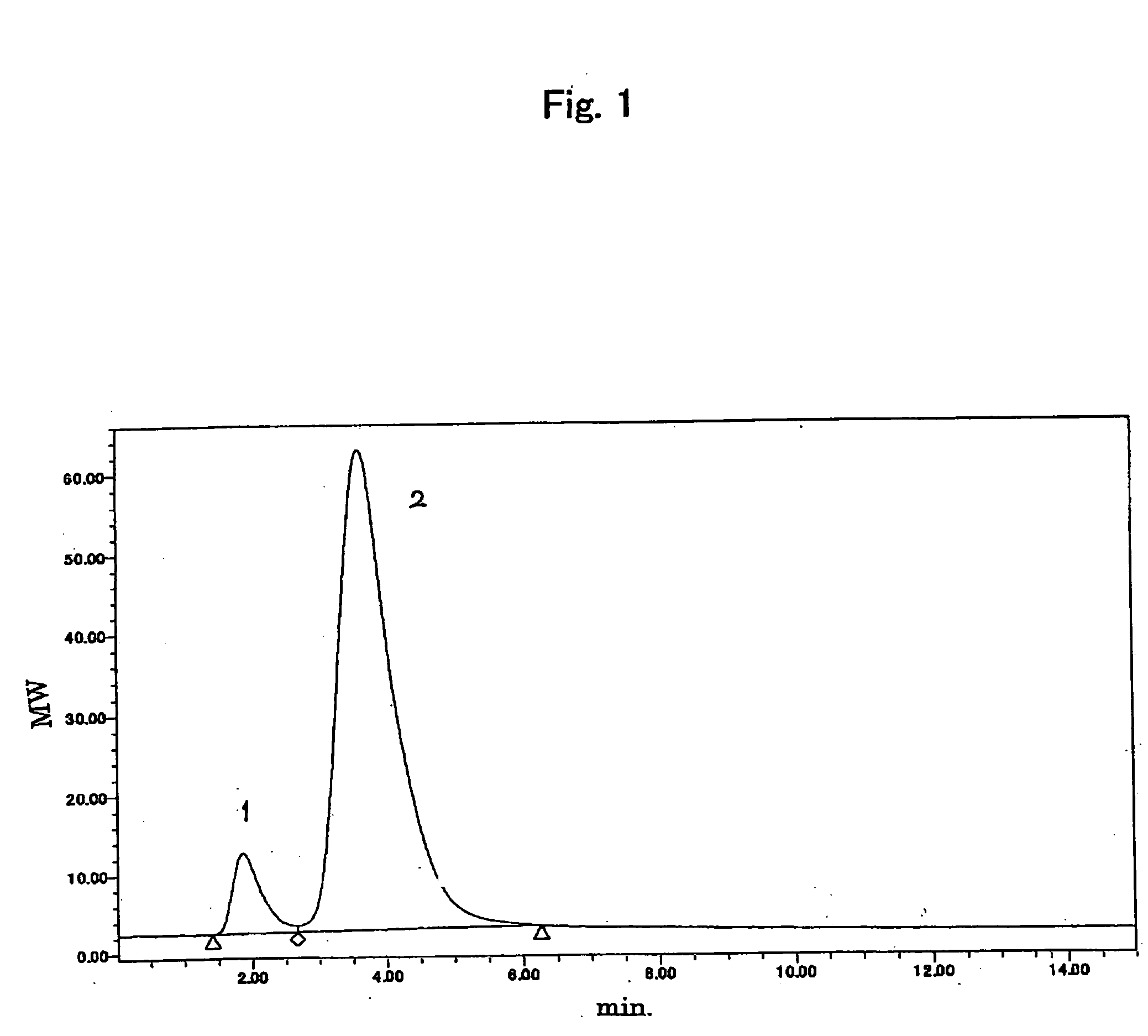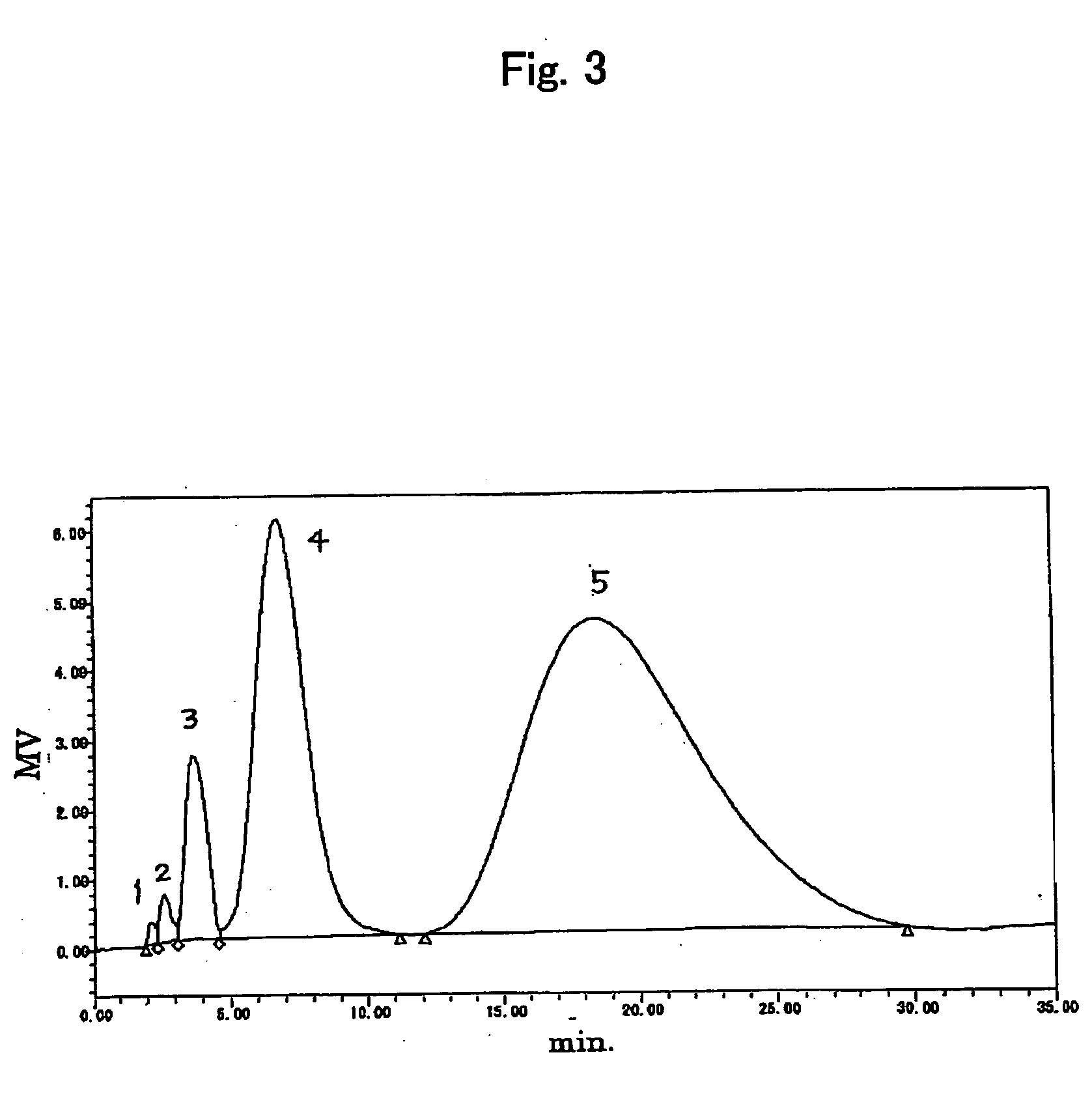Method of analyzing the ratio of activation of terminals of polyoxyalkylene derivatives
a technology of polyoxyalkylene and terminals, applied in the field of analyzing the ratio of activation of terminals of polyoxyalkylene derivatives, can solve the problems of increasing noise and on the shift of base lines, increasing analytical errors, and not increasing, so as to prevent the influence of determination, measure the ratio accurately, and high precision
- Summary
- Abstract
- Description
- Claims
- Application Information
AI Technical Summary
Benefits of technology
Problems solved by technology
Method used
Image
Examples
example 1
[0080]
CH3—(CH2CH2O)225—CH2CH2CHO (6)
[0081] 20 mg of the above polyoxyalkylene derivative (6) (molecular weight of 10000) was dissolved in 2 mL of 0.1 M buffer solution of acetic acid (pH 4.0). 68 μL of methanol solution (40 mg / mL) of p-nitrobenzoic acid was then added and 128 mL of aqueous solution of sodium cyano borohydride (10 mg / mL) was further added to dissolve the derivative. The mixture was stirred for 2 hours at room temperature to proceed the reaction. The whole of the reaction mixture was added into a gel filtration column (PD-10(Amarsham Bioscience)) equilibrated with eluent used for the subsequent HPLC measurement. Eluent is further added so that a fraction of a high molecular weight eluted first was taken in a vial for HPLC measurement. The HPLC measurement was carried out according to the following conditions.
(Measuring conditions for HPLC measurement)
HPLC system: Alliance 6890 (Waters corporation)
Separation column: ES-502N (Asahipak)
Eluent: 1.5 mM buffer so...
example 2
[0085] A sample to be analyzed having a higher molecular weight than in the example 1 used, and the influence on the results and reproducibility of the analytical method were studied.
CH3O (CH2CH2O)680—CH2CH2CHO (7)
[0086] The activation ratio of terminal was measured according to the same procedure as the example 1, for the above polyoxyalkylene derivative (7) having the same structure as the polyoxyalkylene derivative of the example 1 and having a higher molecular weight (molecular weight of 30000). 0.5 mM buffer solution of ammonium formate was used as a eluent for the HPLC measurement. The activation ratio of terminal was proved to be 83.3 percent. The same procedure as described above was repeated and the reproducibility was shown in table 1.
example 3
[0095]
[0096] Two samples (7-1, 7-2) of the above polyoxyalkylene derivative (7) (molecular weight of 20000) were measured for the activation ratio of terminals.
[0097] 20 mg of the above polyoxyalkylene derivative samples (7-1, 7-2) (molecular weight of 20000) were dissolved in 2 mL of maleimide propionic acid aqueous solution (2 mg / mL), respectively. The mixture was stirred for 3 hours at room temperature under shading to provide a sample for measurement. The HPLC measurement was performed according to same procedure as the example 1, except that 1 mM ammonium formate buffer solution (pH 8.0) was used as the eluent.
[0098]FIGS. 3 and 4 show the RI chromatograms of the samples for measurement (7-1) and (7-2). Peak 1 correspond with a non-activated substance, and peaks 2, 3, 4 and 5 correspond with the polyoxyalkylene derivatives (7) having one, two, three and four active functional groups, respectively. Each of the activation ratios of terminals correspond with the above substances ...
PUM
| Property | Measurement | Unit |
|---|---|---|
| inner diameter | aaaaa | aaaaa |
| length | aaaaa | aaaaa |
| pH | aaaaa | aaaaa |
Abstract
Description
Claims
Application Information
 Login to View More
Login to View More - R&D
- Intellectual Property
- Life Sciences
- Materials
- Tech Scout
- Unparalleled Data Quality
- Higher Quality Content
- 60% Fewer Hallucinations
Browse by: Latest US Patents, China's latest patents, Technical Efficacy Thesaurus, Application Domain, Technology Topic, Popular Technical Reports.
© 2025 PatSnap. All rights reserved.Legal|Privacy policy|Modern Slavery Act Transparency Statement|Sitemap|About US| Contact US: help@patsnap.com



